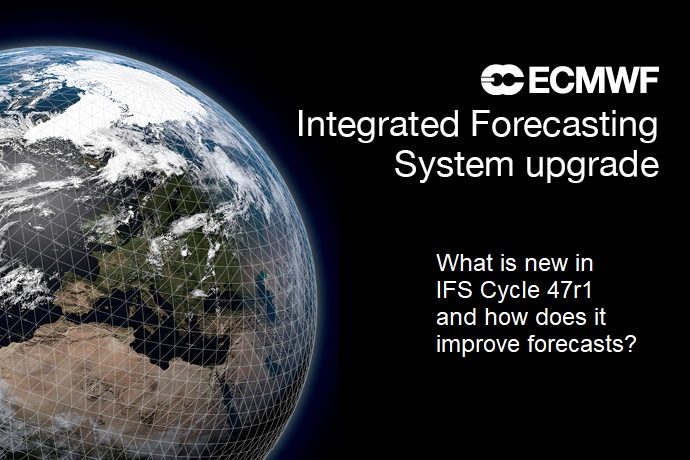Global S&T Development Trend Analysis Platform of Resources and Environment
| IFS upgrade greatly improves forecasts in the stratosphere | |
| admin | |
| 2020-07-01 | |
| 发布年 | 2020 |
| 语种 | 英语 |
| 国家 | 欧洲 |
| 领域 | 地球科学 ; 气候变化 |
| 正文(英文) | 
A wide-ranging upgrade of ECMWF’s Integrated Forecasting System (IFS), implemented on 30 June 2020, improves global weather forecasts and substantially improves analyses and forecasts in the stratosphere. The upgrade to IFS Cycle 47r1 brings many changes in data assimilation and Earth system modelling. It also introduces a new tropical cyclone wind radii product, which will facilitate the identification of wind-related hazards. Better forecastsIFS Cycle 47r1 improves both ECMWF’s high-resolution forecast (HRES) and the ensemble forecast (ENS). The horizontal grid spacing in HRES is about 9 km and in ENS about 18 km. Forecasts of several near-surface parameters, most notably 2-metre temperature and humidity, are better by about 0.5–1%. This is true both in the extratropics and, when verified against observations, in the tropics. Extratropical 10-metre wind in HRES is slightly improved, as is total cloud cover in ENS and HRES.
The prediction of winds in deep tropical cyclones has been improved. (Image: Thinkstock/Stocktreck Images) The upgrade also addresses a longstanding issue with predicted maximum surface winds in tropical cyclones. These have in the past been generally too low, in particular for intense tropical cyclones. The upgrade alleviates the problem by changing the model specification for momentum exchange at the sea surface.
These scatter plots show the relationship between maximum 10-metre wind speed and corresponding minimum mean sea level pressure for 10-day HRES forecasts of 20 tropical cyclones from 00 UTC between 25 August 2019 and 1 January 2020. The dashed line indicates mean central pressure for a given wind speed. The pink circles show corresponding reported values (Best Track data). In IFS Cycle 47r1, predicted wind speed values for deep tropical cyclones are closer to reported values than in IFS Cycle 46r1. Improvements in the stratosphereThe upgrade greatly improves analyses and forecasts in the stratosphere, mainly by reducing large-scale biases. The analysis (our best estimate of the current state of the atmosphere) benefits from a new version of weak-constraint 4D-Var data assimilation. The change means that temperature biases above 100 hPa are reduced by up to 50%.
In weak-constraint 4D-Var, for a parameter x such as temperature, a forcing term η cools the trajectory at every time step to correct for the temperature warm bias in the model. In this formulation of 4D-Var, the error statistics of the model bias need to be calculated offline. They then enter into the calculations through which the data assimilation system determines the optimal combination of initial state and forcing term adjustments. A change in the model has reduced numerical errors accumulating at high horizontal resolution due to insufficient vertical resolution in the stratosphere. This was achieved by moving from third-order (cubic) to fifth-order (quintic) vertical interpolation.
These plots show differences in zonally (latitudinally) averaged temperature between quintic and cubic vertical interpolation forecasts at a grid spacing of about 79 km (left) about 9 km (right). The plots show that quintic vertical interpolation warms the stratosphere more at high horizontal resolution, thus reducing the cold bias at that resolution. Mean values over 31 forecasts starting in July 2017 and valid at day 10 are shown. An accurate representation of the stratosphere is important for weather forecasting because the stratosphere interacts with the troposphere below, where weather happens. It is also important for the correct interpretation of satellite observations. These help to estimate the current state of the atmosphere, from which weather forecasts start. Tropical cyclone wind radiiAmong other changes to forecast outputs, new parameters specify the maximum distance from the centre of a tropical cyclone (TC) to locations where the surface wind speed reaches 34, 50 and 64 knots (wind radii). This information will help users to assess the risk of wind-related hazards.
The chart shows an HRES wind radii forecast using IFS Cycle 47r1 for the 34‑knot wind threshold up to 240 hours ahead, initialised at 00 UTC on 30 August 2019. The red dots indicate the predicted centre of Hurricane Dorian at 12‑hour intervals. In reality, Hurricane Dorian turned northwards slightly earlier, missing the Florida peninsula. The wind radii are computed for each of four quadrants (NE, SE, SW and NW), delivering a total of 12 size metrics for each TC at each time step. Further informationECMWF Director of Research Andy Brown and Director of Forecasts Florian Pappenberger have explained the changes and improvements brought by IFS Cycle 47r1 in two recent webinars: Webinar on what’s new in IFS Cycle 47r1 Webinar on how forecasts are improved in IFS Cycle 47r1 Further information on all aspects of the upgrade is available on the IFS Cycle 47r1 implementation web page. A detailed presentation of the upgrade, including scorecards, will also be included in the summer issue of the ECMWF Newsletter, due to be published later this month. |
| URL | 查看原文 |
| 来源平台 | European Centre for Medium-Range Weather Forecasts |
| 文献类型 | 新闻 |
| 条目标识符 | http://119.78.100.173/C666/handle/2XK7JSWQ/280794 |
| 专题 | 地球科学 气候变化 |
| 推荐引用方式 GB/T 7714 | admin. IFS upgrade greatly improves forecasts in the stratosphere. 2020. |
| 条目包含的文件 | 条目无相关文件。 | |||||
| 个性服务 |
| 推荐该条目 |
| 保存到收藏夹 |
| 查看访问统计 |
| 导出为Endnote文件 |
| 谷歌学术 |
| 谷歌学术中相似的文章 |
| [admin]的文章 |
| 百度学术 |
| 百度学术中相似的文章 |
| [admin]的文章 |
| 必应学术 |
| 必应学术中相似的文章 |
| [admin]的文章 |
| 相关权益政策 |
| 暂无数据 |
| 收藏/分享 |
除非特别说明,本系统中所有内容都受版权保护,并保留所有权利。
修改评论